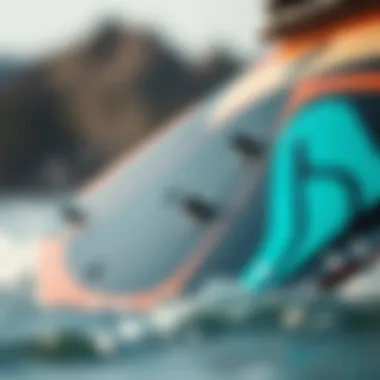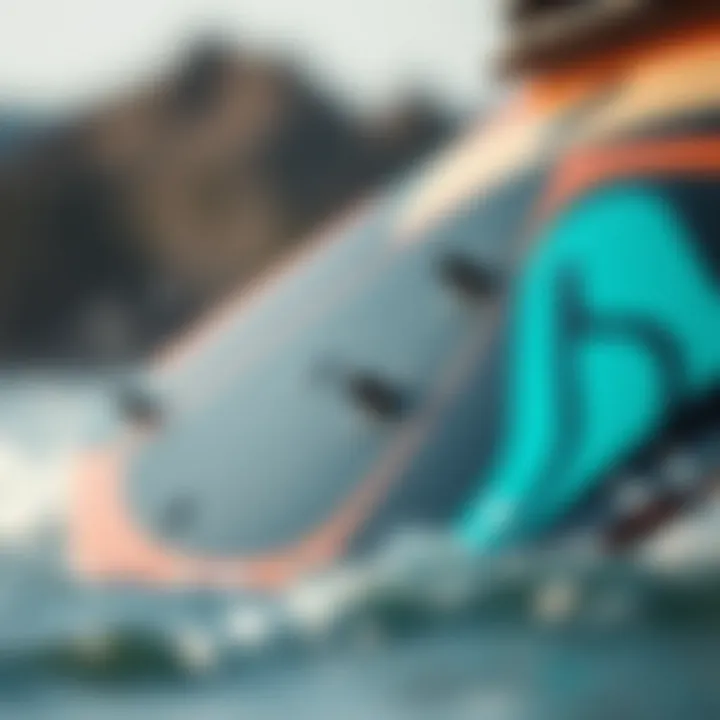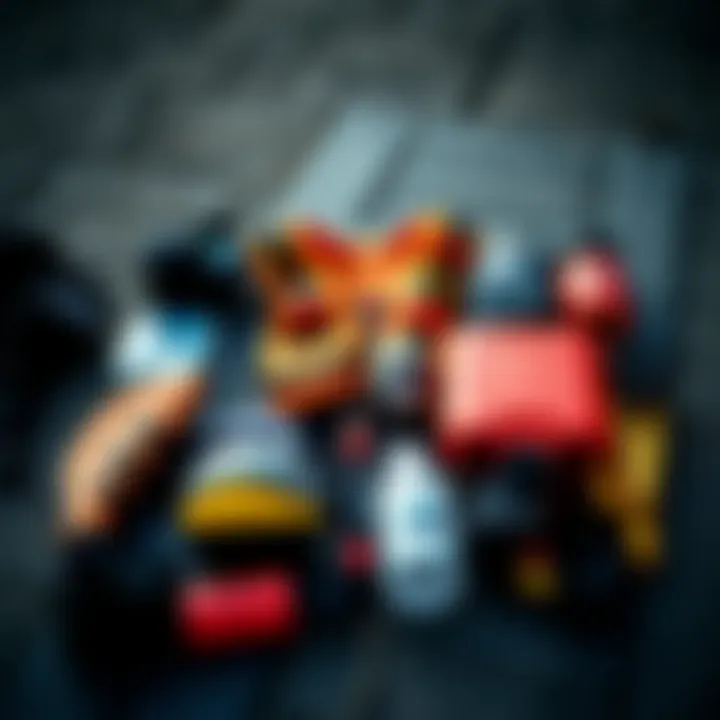Understanding Wakefoil Boards: A Comprehensive Guide


Intro
As the waves crash and the horizon stretches endlessly, the thrill of wakefoiling beckons kiteboarders to explore uncharted waters. To navigate this exhilarating sport, understanding the essential tools—specifically, wakefoil boards—is paramount. This guide will unravel the technical intricacies of wakefoiling, covering its design, its diverse applications, and the importance of selecting the right board. Whether you're a novice eager to learn or an adept rider looking to finesse your technique, this comprehensive overview is crafted to elevate your wakefoiling experience.
Equipment Insights
Latest Gear Reviews
In an ever-evolving sport like wakefoiling, keeping up with the latest equipment is fundamental. Today's boards come packed with advancements that influence performance, stability, and ride quality. Notable brands like Liquid Force and Slingshot each push the envelope with their unique designs. The Liquid Force Rocket is particularly renowned for its versatility, blending smoothly between slalom and freeride styles. On the other hand, Slingshot's Phantom series is distinguished for its lightweight construction and responsive handling, making it ideal for both seasoned riders and those just beginning.
**"Choosing the right board isn't just about looks; it’s about how it feels beneath your feet."
To aid your decision-making, consider these features when evaluating wakefoil boards:
- Material Composition: Boards can be made from various materials like carbon, fiberglass, and wood. Each material contributes differently to weight, flex, and durability.
- Foil Size: Bigger foils provide more lift and stability but might be tougher for advanced moves. Smaller foils offer agility but require finesse to master.
- Board Shape: A wider tail can enhance stability, while a narrower design facilitates quicker turns.
Maintaining awareness of gear trends ensures you're equipped with the best tools tailored to your riding style.
Essential Gear Maintenance
Taking care of your wakefoil gear guarantees longevity and peak performance. Here are some crucial maintenance tips:
- Regular Cleaning: After each session, give your board a good rinse. Saltwater and sand can degrade the material over time.
- Inspect for Damage: Look for dings, scratches, or delamination. Minor issues can escalate if left unchecked.
- Storage Conditions: Keep your board in a cool, dry environment when not in use. Extreme heat can warp boards, while damp conditions can promote mold.
Investing a little effort into how you care for your equipment greatly extends its life, ensuring you're consistently ready for action.
Technique Exploration
Beginner Techniques
For those just entering the world of wakefoiling, mastering the fundamentals is key. Start with the following techniques:
- Weight Distribution: Balance your weight over the board to maintain stability. Lean slightly back to generate lift.
- Starting Position: Begin with one knee on the board and the other foot on the foil. Gradually rise as you gain confidence and stability.
- Paddle Power: Use a paddle or the boat’s power to help propel you until you feel comfortable controlling your speed and direction.
Advanced Maneuvers
Once you've conquered the basics, it's time to up your game. Advanced techniques include:
- Jumps and Tricks: Learn the art of popping off the water and executing spins. It requires fine-tuning your timing and balance.
- Transitions: Perfecting the shift from heel-to-toe edge enhances maneuverability and control.
- Carving: Practicing turns without losing lift is essential for progressing to more dynamic riding styles.
Engaging in regular practice and understanding these techniques can elevate your riding from novice to expert in no time.
Closure
Understanding wakefoil boards involves not just knowledge of gear but also the nuances of riding technique. With the right board and proper care, every outing can be a step towards mastering this exhilarating sport. So, prepare yourself, hit the waters, and let the adventure unfold.
Intro to Wakefoil Boards
Wakefoiling has seen a significant rise in interest among water sports enthusiasts. This thrilling activity not only provides an exciting way to enjoy water but also opens up new horizons for those keen on exploring the waves. In understanding wakefoil boards, we become equipped not only with the knowledge needed to choose the right equipment but also to appreciate the tactical nuances of using them effectively.
What Is a Wakefoil Board?
A wakefoil board is essentially a surfboard with a unique twist; it incorporates a hydrofoil that extends below the water's surface. This foil, resembling a wing, generates lift, allowing the rider to glide above the water. This magic moment of rising above the waves can be likened to an eagle soaring in the sky, gracefully detached from the forces of gravity. The combination of the board and the foil facilitates riding with significantly less drag, enabling speeds that would challenge traditional wakeboarding methods.
This board's versatility can be seen in various settings, whether pulling from a jet ski, a boat, or during kiteboarding. As the learner gradually becomes accustomed to the unique sensations of foiling, the possibilities for tricks and advanced maneuvers expand exponentially.
Historical Background and Evolution
The concept of wakefoiling has roots that might surprise you. It traces back to designs of rudimentary surfboards and the engineering principles of aviation. The early stages of foiling can be attributed to the pioneering spirit of surfers in Hawaii, who first experimented with lift-generating fins in the ocean. Fast forward to recent decades, and innovation took center stage with companies like Lift Foils and Slingshot, which improved materials and designs to enhance performance.
Evolutionarily speaking, wakefoiling has transitioned from niche to mainstream, thanks to technological advances in materials and the pursuit of adrenaline among water sports enthusiasts. Here’s a brief timeline of key developments:
- Late 20th Century: Initial designs of watercraft aimed at maximizing lift.
- Early 2000s: Introduction of foils specifically for surfing and wakeboarding, gaining traction in coastal communities.
- 2010s: Emergence of dedicated wakefoil boards, marked by a growing enthusiast community and competitive events.
- Current Era: Heightened technological developments leading to lighter, stronger materials that enhance performance and user experience.
As you see, the history of wakefoil boards is as dynamic as the sport itself. Understanding this background helps riders appreciate the intricate designs and innovations that go into modern equipment, not to mention set the stage for future advancements.
"Wakefoiling combines exhilaration with innovation, making it both a sport and an art."


For more details on wakefoiling and its advancements, you may refer to resources like Wikipedia and forums on platforms like Reddit. This allows both fledgling and experienced riders to exchange ideas, tricks, and tips.
Understanding wakefoil boards paves the way for navigating the exhilarating world of water sports and knowing the finer points can make all the difference between a good and unforgettable experience.
Construction of Wakefoil Boards
The construction of wakefoil boards serves as the backbone of their performance and overall user experience in the sport. Since the ride quality can make or break a session on the water, understanding how these boards are made is crucial for anyone looking to enhance their wakefoiling skills. Right from materials to design features, each element plays an important role in maneuverability, stability, and speed.
Materials Used in Manufacturing
The selection of materials is pivotal in the creation of a wakefoil board. Manufacturers often choose between different types because the choice influences not only the weight but also flexibility and durability of the board. Some common materials include:
- EVA Foam: Used for foot pads, this material offers excellent grip and comfort, reducing fatigue during extended sessions.
- Fiberglass: Lightweight yet strong, fiberglass provides the structural integrity needed without adding too much weight.
- Carbon Fiber: For high-performance boards, carbon fiber is favored for its strength-to-weight ratio. It allows for quicker acceleration and responsiveness in the water.
- Polyurethane Foam: This material is often used in core construction. It's lightweight and helps in buoyancy, essential for performance.
Choosing the right material can directly impact your ride. Boards made with lighter materials are easier to handle, especially for beginners trying to establish their balance. However, sturdier boards made from heavier materials can withstand harsher conditions, catering to more advanced riders looking to push limits.
"A well-constructed wakefoil board can elevate your experience and open avenues for new tricks and maneuvers."
Design Features Influencing Performance
The design of a wakefoil board encapsulates more than just aesthetics. Each feature is engineered with performance in mind, and understanding these nuances makes all the difference.
- Shape and Profile: The outline of the board affects its tracking and turning capabilities. A board with a wider tail, for instance, may offer increased stability, making it more forgiving for newcomers.
- Foil Placement: The positioning of the foil, which can be adjusted on some boards, influences lift and how quickly a rider can get on top of the water. Riders looking for speed may prefer a forward position, while those pursuing tricks may opt for a rear placement for better maneuverability.
- Rockers: The curve of the board from tip to tail—known as rocker—can affect how easily the board enters the water. A more pronounced rocker helps with navigating choppy conditions, while a flatter rocker often leads to faster rides.
Each of these design elements plays a role in how a rider interacts with the water. A well-designed wakefoil board balances these aspects for optimal performance, allowing both novices and experienced riders to enjoy themselves to the fullest.
In summary, the construction of wakefoil boards directly influences a rider's experience. Material choices and design features work in tandem to provide everything from maneuverability to durability, making it essential for riders to consider these factors before diving into their next wakefoiling adventure. Understanding these intricacies can significantly enhance one’s time on the water.
Types of Wakefoil Boards
Understanding the different types of wakefoil boards is crucial for anyone keen on diving into this exhilarating sport. Each type of board caters to distinct riding styles, skill levels, and conditions, offering options for everyone from beginners to seasoned pros. Selecting the right type can significantly influence your performance and enjoyment on the water, making it not just a matter of preference, but also of practicality.
All-Around Wakefoil Boards
All-around wakefoil boards are designed for versatility and usability, making them the ideal choice for newcomers. These boards typically have a balanced design, which allows riders to experience a range of conditions without compromising performance. Their wider profile and moderate rocker make them stable during early sessions, especially when learning the ropes.
Whether you're just getting used to the water or want to perform basic tricks, an all-around board provides a solid foundation. The most notable aspect is their adaptability; it doesn’t matter if you choose to ride it behind a boat, use a jet ski, or experiment with a kite. Many riders appreciate their forgiving nature, allowing for smoother landings and less tiring experience overall.
“Choosing an all-around wakefoil board often leads to a more enjoyable learning curve, helping beginners gain the confidence they need.”
Freestyle Wakefoil Boards
Freestyle wakefoil boards offer a different thrill altogether. Designed for tricks and jumps, they often have a smaller size, a more aggressive rocker, and are lighter than all-around boards. This construction allows for quicker maneuverability, which is essential for executing stunts such as spins, flips, and other aerial tricks. The ideal choice for those who wish to express their creativity on the water.
If you're drawn to the idea of performing daring feats, then a freestyle board is worth considering. However, these boards typically require a higher skill level and familiarity with foil riding dynamics.
In addition, to achieve optimal performance, they often need specific foot placements to allow for better balance and control during complicated transitions. It's a whole new world of opportunities for those willing to take on the challenge.
Surf Style Wakefoil Boards
Surf style wakefoil boards come with a design tailored specifically for riders inspired by ocean surfing. They often feature a longer and narrower shape that closely resembles traditional surfboards. This construction helps to mimic the feel of riding waves, allowing riders to make smooth, flowing movements.
The unique design of surf style boards can contribute to an enhanced experience when it comes to carving and turning, offering the sensation of gliding over water much like riding a wave. While they do require a bit of skill, surfers transitioning to wakefoiling usually find them comfortable, as they can utilize many of their existing skills and techniques from surfing.
In summary, each type of wakefoil board provides its unique flavor of experience. All-around boards are perfect for those just starting, while freestyle boards cater to adventurous types looking for thrills. Surf style boards serve as a bridge for surfers wanting to enjoy their sport on flat water. Understanding these nuances will surely impact your time on the water, enabling you to make informed choices tailored to your preferences.
Choosing the Right Wakefoil Board
Selecting the appropriate wakefoil board is akin to choosing the right pair of shoes—each type serves a unique purpose and requires careful consideration. The choice can dictate not only the enjoyment of the experience but also one's safety and progression in the sport. A well-suited board can help you perform at your best, while an improper fit may lead to frustration and diminished enthusiasm. In this section, we will explore various factors that play a pivotal role in making this important decision, followed by insights into aligning the right board with your skill level.
Factors to Consider
When it comes to choosing a wakefoil board, there are several critical factors to mull over:
- Board Size: The dimensions of the board can make a world of difference. Larger boards offer stability and are easier to balance on for beginners, while smaller boards provide greater maneuverability and agility for experienced riders.
- Volume and Weight: Boards with a higher volume can float better and are great for riders with a heavier build. On the flip side, lighter boards can enhance performance, especially for advanced maneuvers.
- Foil Connection: It's important to consider how the foil attaches to the board. Different mounting systems can affect the overall feel and responsiveness of the ride.
- Material: The board's construction material impacts durability and performance. Materials like carbon fiber can make a board lightweight and stiff, thus aiding speed, while more traditional materials like fiberglass provide a balanced experience.
"Selecting the right board isn't just about personal preference—it's about happy accidents and finding what feels right in the moment."
- Riding Style: Reflect on what style of riding you plan to pursue. Are you after the thrill of tricks, or is a smooth cruise more your speed? Understanding your approach will help narrow down your options significantly.


These factors, combined with a clear understanding of one’s personal preferences, can pave the way for making an informed choice in wakefoil boards.
Skill Level and Board Selection
Your skill level is perhaps one of the most crucial aspects to consider when selecting a wakefoil board. Just as a novice skier wouldn’t jump into the big leagues without first hitting the bunny slopes, wakefoil enthusiasts should also recognize their proficiency before diving into the purchasing pool. Here are some guidelines:
- Beginner: If you're just starting out, look for wide boards with a larger surface area that provide more stability. Boards like the Hyperlite Hurley 5'2" often fit this bill, offering easy balance and smooth take-offs. A softer flex can also make rough landings more forgiving.
- Intermediate: As skills develop, consider boards like the Slingshot Screamer which offer a blend of stability and agility. These boards allow for control during tricks while still providing enough support to venture into more challenging maneuvers.
- Advanced: For the seasoned pros, a board like the Liquid Force Rocket will likely suit your needs. It’s designed for speed and agility, allowing precise movements and rapid direction changes that experienced riders crave.
Remember, each rider's experience will differ, and what works for one person may not be ideal for another. Testing boards, if possible, before committing is always a wise approach. Through diligent consideration, one can find a board that not only enhances their skills but also fuels a passion for wakefoiling that extends well beyond the initial learning curve.
By keeping these aspects in mind, kiteboarders, instructors, and enthusiasts alike can better navigate the choices available, ensuring an enjoyable and rewarding experience on the water.
Techniques and Best Practices
Wakefoiling is not just about balance and speed; it’s an intricate dance between rider and water. Understanding the techniques and best practices involved can significantly enhance your experience on the board, making every session more enjoyable and safe. By mastering these techniques, athletes can effectively navigate challenging waters, perfect tricks, and even extend their riding seasons, all while ensuring their equipment lasts longer and remains in top-notch condition.
Getting Started with Wakefoiling
For those new to wakefoiling, the initial steps can feel like stepping into a new world. Begin with the right mindset. It's crucial to approach your first attempts with patience and a willingness to learn. Here are some basic techniques that can help you get your feet wet, quite literally:
- Select the Right Equipment: Start with a board that matches your skill level. Beginners might prefer larger boards that provide more stability. Brands like Slingshot and Liquid Force have superb entry-level options.
- Practice on Land: Before hitting the water, practice your stance and balance on land. Stand on your board, knees slightly bent, and get a feel for the position that feels most natural.
- Find Suitable Water Conditions: Calm water is your friend. Lakes and bays often provide a smoother surface than oceans, making it easier to learn the ropes.
- Use a Towrope: Having a reliable towrope is essential for beginners. It allows you to focus on your balance while being pulled along.
- Focus on Body Position: Keep your weight centered over the board and maintain a relaxed posture. A rigid stance can lead to falls, so flexibility is key here.
Once you’re comfortable with these fundamental aspects, it’s time to venture onto the water. Start slow to gain confidence and gradually increase your speed as you become more adept.
Advanced Maneuvers and Tricks
For seasoned riders, the world of wakefoiling opens up a new horizon filled with exciting tricks and maneuvers. Advancing your skills involves understanding both the physical techniques and the mental strategies required to execute maneuvers smoothly.
- Carving Turns: This is a critical skill for any wakefoiler. Utilize your body weight to shift when making turns. Lean gently into the turn and allow the board to pivot underfoot. Control is crucial here to maintain your speed and balance.
- Jumping: This requires a combination of speed and timing. As you approach a wave or a small ramp, crouch slightly and then push off with your feet. This takes practice but results in a thrilling ride.
- Tricks like 180s and 360s: Once you're comfortable jumping, these tricks come next. For a 180, turn your shoulders and use your feet to guide the board around. For 360s, combine the jumping technique with a sharp turn of your body mid-air. This may take multiple attempts to get right, but the feeling of landing it makes it worthwhile.
- Practicing Falls: Accept that falls will happen. Knowing how to fall safely can make a significant difference in your overall safety. Tuck your limbs close to your body and try to fall away from the board to reduce the risk of injury.
"Success is not final; failure is not fatal: It is the courage to continue that counts." – Winston Churchill
Following these clearly defined steps and techniques will not only improve your skills but also enhance your appreciation for the sport of wakefoiling.
Maintenance and Care for Wakefoil Boards
When it comes to wakefoiling, enthusiasts often focus on the thrill of gliding above the water, the wind in their hair, and the exhilaration of nailing a new trick. However, just like any other sport equipment, wakefoil boards require regular maintenance and proper care to ensure they perform at their best. Neglecting these aspects can lead to subpar performance and affect the longevity of your gear. Therefore, understanding the maintenance and care of wakefoil boards is not just about keeping them looking good; it’s about enhancing your overall wakefoiling experience.
Regular Maintenance Routines
Routine checks are the heart of any maintenance plan. Like oiling your car or giving your bicycle a good wash, your wakefoil board also benefits from regular inspections. This includes checking for any cracks, scratches, or signs of wear and tear. To keep everything shipshape, consider these steps:
- Inspect the Foil: Check for any dents or bends. The foil directly affects lift and stability, so any damage here could lead to serious performance issues.
- Look at the Board Surface: Scratches may seem cosmetic but they can affect hydrodynamics. Light scratches can typically be sanded out, but deep gouges might need professional attention.
- Assembly Integrity: Tighten any screws or hardware, ensuring that nothing is loose. A loose connection can turn a fun ride into a precarious tumble.
- Wash After Use: After a session, especially in salt water, rinse with fresh water. Salt can corrode materials over time, leading to trouble when you least expect it.
These habits don’t take a lot of time but contribute significantly to the upkeep of your board. It’s all about investing a little effort to avoid massive headaches down the road.
Storage and Transport Guidelines
Where you keep your wakefoil board plays a crucial role in its life span. A little common sense goes a long way here. Improper storage can lead to warping or damage. Here are some practical tips:
- Cool, Dry Location: Always store your board in a shaded area, away from direct sunlight. UV rays can weaken the materials, making your board more susceptible to damage.
- Avoid Extreme Temperatures: Don’t leave your board in a hot car for prolonged periods, as heat can warp the board and foil. Extreme cold isn't great either; it can make materials brittle.
- Use a Board Bag for Transport: When traveling, protect your board in a padded bag, especially during air travel. This minimizes shocks and bumps that could cause damage.
- Upright Position: When storing, keep the board upright if possible. Leaning it against a wall might cause it to bend over time.
By adhering to these routines and guidelines, you not only extend the life of your wakefoil board but also ensure you are always ready to hit the water when the mood strikes.
By investing a little time into maintenance and care, wakefoiling becomes a consistent joy rather than a frustrating hassle. Your board is your partner in the water, so treat it well, and it will reward you with many thrilling rides ahead.
Safety Considerations in Wakefoiling
When it comes to engaging in any watersport, safety isn’t just a suggestion—it’s the cornerstone of enjoyable and secure experiences. In wakefoiling, where riders are perched on a board elevated above the water, this becomes even more critical. Understanding safety considerations ensures not only a thrilling ride but also protects participants from potential dangers.
The sport epitomizes freedom and fun, yet hazards such as equipment failure, collision, and the ever-changing nature of water surfaces must be at the forefront of every wakefoiler's mind. Serious injuries can happen in the blink of an eye, particularly for those who might be pushed too far beyond their capabilities or fail to respect safety protocols. Thus, both novices and veterans need to pay attention to the essentials of safety gear and practices.
Essential Safety Gear
Equipping oneself with appropriate safety gear is non-negotiable for anyone looking to navigate the waters on a wakefoil board. Here’s a rundown of essential pieces of equipment:
- Life Jacket: A good quality personal flotation device (PFD) is vital. It should fit snugly but allow for movement. Look for one that is specifically rated for watersports for optimal protection.
- Helmet: Head injuries can be severe. A helmet designed for water sports provides protection against impacts, particularly in areas with obstacles.
- Impact Vest: While not mandatory, an impact vest can cushion falls and offer additional support to your torso. This is especially useful for those attempting tricks or racing at high speeds.
- Wetsuit or Dry Suit: Depending on water temperature, these suits provide thermal protection and prevent hypothermia. Choose one suited to the conditions to ensure comfort throughout your activity.
- Leash: A leash secures the board to your leg, keeping it from becoming a runaway projectile, which can be a serious hazard to both you and others on the water.


In keeping with the spirit of safety, remember that gear is only as good as how well it is maintained. Regular checks for damage and fit can save lives.
Safety Practices and Tips
Beyond having the right gear, it is just as important to adopt sound safety practices while wakefoiling. Here are some recommended tips to keep in mind:
- Assess the Conditions: Always evaluate water and weather conditions before heading out. Rough waters or high winds can make for dangerous situations.
- Buddy System: If you can, go wakefoiling with a partner. Having someone nearby can help in case of unexpected difficulties.
- Know Your Limits: It’s easy to get swept up in the excitement, but pushing yourself too hard or too fast can lead to accidents. Respect your limitations.
- Signal Awareness: Communicate with your boat driver and fellow riders. Using hand signals can keep everyone apprised of plans and movements, reducing the chance of collisions.
- Practice Falling: Falling is an inherent part of wakefoiling. Learn to fall safely by avoiding using your arms to break a fall or twisting your body mid-air.
"Preparation is key; it isn’t an afterthought. It’s what divides a thrilling ride from a dangerous escapade."
By embracing meticulous safety measures and valuing equipment maintenance, wakefoiling can be both exhilarating and safe, allowing enthusiasts to appreciate the water like never before.
Popular Destinations for Wakefoiling
When talking about wakefoiling, the choice of location can make or break the experience. Destinations not only offer beautiful backdrops, they also come with unique water conditions that suit different skill levels. Picking the right spot to hit the water can enhance fun and safety in equal measure.
Top Locations Around the World
In the realm of wakefoiling, some locations are legend. Here are a few that kiteboarders swear by:
- Lake Havasu, Arizona: Known for its warm weather and stunning scenery, Lake Havasu is a favorite among enthusiasts. Its clear water and minimal boat traffic make it ideal for both beginners and seasoned pros alike.
- The Florida Keys, Florida: With its extensive coastline and majestic turquoise waters, the Florida Keys provide multiple spots for wakefoiling. This area offers consistent winds and warm waters, making it a year-round destination.
- Cape Town, South Africa: A mecca for thrill-seekers, Cape Town boasts powerful winds and breathtaking views of Table Mountain. The waters around Kite Beach are perfect for various maneuvers, attracting countless kiteboarders from around the globe.
- Maui, Hawaii: Maui's beaches offer consistent winds and waves that attract experienced wakefoilers. The scenic beauty adds to the allure, making it a bucket-list destination for many.
- Cebu, Philippines: Off the beaten path, Cebu features less crowded waters along with beautiful sandy beaches and a tropical climate, providing an ideal environment for a memorable foiling experience.
Local Spots and Hidden Gems
Just like any sport, sometimes it’s the tucked-away locations that hold the most promise. Here are a few local spots worth exploring:
- Bonaire, Caribbean: Known as a kiteboarding paradise, Bonaire's flat waters and consistent trade winds create perfect conditions for wakefoiling. Its warm and shallow lagoons are ideal for those learning new tricks.
- Lake Champlain, Vermont: While not the first place that comes to mind for wakefoiling, Lake Champlain is full of charm. Its quiet spots are perfect for enjoying peaceful sessions away from the hustle.
- Burlington, Vermont: Tucked away on Lake Champlain, this city gives access to vibrant culture and a welcoming community of water sports enthusiasts.
- Pine Lake, Oregon: Often overlooked, Pine Lake offers plenty of space and far fewer crowds. It combines beautiful surroundings with calm waters that can be navigating easily thanks to local guidance.
- The Ionian Sea, Greece: While Greece is renowned for its historical sites, its lesser-known coastal spots provide astonishingly clear waters and a friendly atmosphere for both beginners and experts.
Finding the perfect spot for wakefoiling is essential not only for skill improvement but also for creating unforgettable memories.
In summary, whether you prefer the buzz of famous kite spots or the serenity of hidden lakes, there is a wealth of options for wakefoiling enthusiasts. These locations offer a mix of natural beauty, supportive communities, and exciting conditions that cater to all levels. Getting to know these destinations is crucial for both safety and enjoyment in this thrilling sport.
The Future of Wakefoiling
Looking ahead, the future of wakefoiling is rife with excitement and promise. The sport has gained traction rapidly over the last few years, cultivating a community of passionate enthusiasts. This growth isn't just about the thrill of riding the waves; it also encompasses advancements in technology and a vibrant culture that's shaping what’s next for wakefoiling and its dedicated followers.
Technological Advancements
Recent innovations play a pivotal role in the evolution of wakefoiling. For instance, the design of boards and foils has seen immense improvements. New materials like carbon fiber and advanced composites have made boards lighter and more durable. These advancements allow riders to experience superior performance on the water. For example, the incorporation of hydrodynamic shapes can lead to smoother gliding and better maneuverability.
Key Innovations include:
- Smart Foils: Some manufacturers are now exploring the integration of electronics that monitor performance metrics, such as speed, height, and stability. This data can provide valuable insights to riders looking to refine their technique.
- Eco-Friendly Materials: As environmental concerns grow, manufacturers are also working towards creating eco-friendly boards, using sustainable materials without compromising quality.
- Foiling Systems: Innovations in the foil systems have made them easier to assemble and disassemble, providing convenience for those transporting their gear to different locations.
With these technological advancements, the barriers to entry are lowering, making the sport more accessible to newcomers. As the gear becomes easier to use, more people may be drawn into the world of wakefoiling, diversifying the community.
"Advancements in technology not only enhance the equipment but also enrich the overall experience of wakefoiling, inviting more people to enjoy this exhilarating sport."
Growth of the Sport and Community
The community surrounding wakefoiling is expanding at a rapid pace. Local clubs and online forums, such as those found on platforms like Reddit and Facebook, serve as hubs for enthusiasts to share tips, organize meet-ups, and plan events. Initiatives such as community competitions have become a regular occurrence, fostering a sense of camaraderie among riders.
The sport is not just about personal achievement; it’s about shared adventures and community spirit. For instance, local meetups can inspire collaborations between experienced riders and novices, emphasizing skill development and safety in a fun, supportive manner. The growth of wakefoil-specific schools and workshops is another indicator of this upward trend, offering targeted training to help riders improve, regardless of their starting point.
Looking deeper, social media plays a central role in how the sport is marketed and how community members connect. Riders share videos of their feats, creating a rich tapestry of content that fuels interest and showcases the sport's potential. Platforms like Instagram and TikTok provide visual platforms for riders to share their journey, making it easier for others to get involved.
End
As we wrap up this exploration into the world of wakefoil boards, it's essential to understand the significance of what we've discussed. The conclusion acts as a cohesive summary, bringing together key insights that can help both seasoned riders and newcomers appreciate the sport more fully.
Summarizing Key Insights
The primary takeaways from the article highlight several core aspects of wakefoiling:
- Understanding Board Types: Knowing the differences between all-around, freestyle, and surf style boards can drastically affect performance and enjoyment. Selecting the right type based on one's skill level and riding style is crucial.
- Construction Matters: Delving into the materials and design features utilized in wakefoil boards illustrates the complexity behind creating a board that caters to various performance needs and preferences.
- Maintenance Practices: Regular upkeep can prolong the life of a wakefoil board, ensuring optimal performance. Riders should develop a routine that not only keeps their gear in peak condition but also enhances their overall experience.
- Safety First: Emphasizing essential safety gear and best practices cannot be overstated. This ensures that the thrill of wakefoiling does not come at the expense of safety or well-being.
- Community and Growth: As wakefoiling continues to gain popularity, the significance of engaging with local communities and attending events fosters a sense of belonging and shared passion.
Overall, this guide sheds light on the seamless blend of technical knowledge and practical insights necessary for enjoying wakefoiling in a safe and informed way.
Looking Ahead and Getting Involved
With the future of wakefoiling edging towards exciting technological advancements and a broader community, there are ample opportunities for enthusiasts to get involved:
- Innovations in Gear: Travelers and riders should keep an eye on upcoming gear releases and innovations that enhance performance, focusing on lighter materials and improved hydrodynamics.
- Local Events and Meet-ups: Participating in local meet-ups, workshops, or competitions not only cultivates skills but also builds relationships with fellow wakefoiling enthusiasts. Consider exploring forums or platforms like Facebook groups or Reddit communities.
- Online Learning Resources: There is no shortage of online tutorials and instructional videos aimed at improving skills. Websites like en.wikipedia.org, britannica.com, and specialized forums can provide valuable insights to aspiring wakefoilers.
- Environmental Responsibility: It's imperative to engage responsibly with the environment while enjoying wakefoiling. This involves understanding local regulations and practicing sustainable behaviors on the water.
In summary, an informed approach to wakefoiling offers rewards beyond just the thrill of the ride. The journey involves nurturing a love for the sport while contributing positively to its community and environment.







